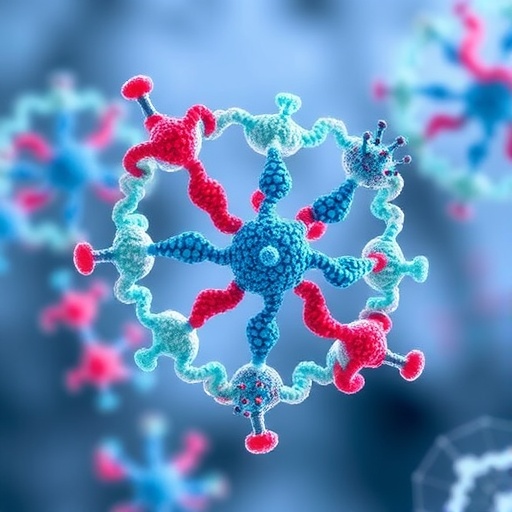In a groundbreaking advancement at the intersection of synthetic biology and protein engineering, researchers at the University of Washington’s Institute for Protein Design have successfully created functional calcium ion channels from the ground up. Utilizing artificial intelligence-powered design strategies, these novel channels were engineered to recapitulate the precise ion selectivity hallmarking naturally occurring calcium channels, with the ability to discriminate calcium ions over others such as sodium by a factor of five. This achievement, detailed in a recent article published in Nature, represents a paradigm shift for biochemical design and offers promising new tools for biomedical research across diverse fields including neuroscience, cardiology, and synthetic cell biology.
Calcium ion channels are integral membrane proteins playing crucial roles in cellular excitability by regulating calcium influx through cell membranes in excitable tissues like nerves and muscles. These ion passages underlie essential physiological phenomena such as neurotransmitter release, muscle contraction, and heartbeat regulation. Naturally evolved calcium channels have long been the object of intensive studies aiming to understand their complex structure-function relationships. Despite sophisticated biochemical characterizations over decades, many molecular details about their gating and ion selectivity remain elusive. The UW team decided to take a novel approach: designing calcium channels entirely from first principles using computational models guided by cutting-edge AI, thereby transcending existing limitations inherent to natural or modified protein scaffolds.
Central to their methodology was the employment of RFdiffusion, an AI-driven platform leveraging deep learning to generate protein backbones that conform to specified structural constraints. Contrasting with the common approach of protein engineering that starts from known scaffolds, these researchers initiated channel design from the precise geometry of the selectivity filter, a critical structural element responsible for discriminating calcium ions from other ions. They then expanded outward, building supporting transmembrane helices and extracellular domains to produce fully functional, stable channel proteins that embed within lipid bilayers mimicking natural membranes. Such membrane protein design posed a formidable challenge since most existing protein databases and AI model training datasets are biased towards soluble proteins, necessitating bespoke adaptations for membrane-embedded channel architectures.
The newly designed channels were biosynthesized in insect cells, providing a biologically realistic environment to ensure proper folding and membrane insertion. Functionality was rigorously validated through patch-clamp electrophysiology, a gold-standard technique for measuring ionic currents across membranes at the single-channel level. These experiments confirmed that several designed constructs generated calcium-selective currents consistent with natural channel behavior, demonstrating not only functional ion conduction but also measurable selectivity favoring calcium ions over sodium ions by approximately fivefold. This level of specificity is remarkable given that achieving precise ion selectivity in synthetic channels has been a longstanding objective and bottleneck in channel engineering.
Complementing functional assays, high-resolution cryoelectron microscopy (cryo-EM) provided structural validation by revealing one of the synthesized channels folds and assembles exactly as predicted by computational models. The atomic-resolution structure allowed comparison of the experimentally determined protein backbone coordinates against in silico designs with astonishing congruence, underscoring the predictive accuracy of AI-guided design workflows. This convergence of computational and experimental data confirms the feasibility of bottom-up design strategies to generate complex, highly specialized biochemical machines heretofore restricted to natural evolution.
Beyond their immediate experimental success, the implications for broader scientific research are profound. The ability to custom-build ion channels with tunable selectivity and gating properties opens new avenues to dissect fundamental principles underpinning transmembrane ion conduction. Moreover, the potential to engineer synthetic channels selective for metals other than calcium could illuminate physiological processes involving metal ions in areas such as immunology and brain signaling. These designed proteins may also serve as integral components in synthetic biology platforms for signal transduction, enabling artificially controlled cell signaling circuits for therapeutic and biotechnological applications.
The project was led by Yulai Liu, a visionary postdoctoral scholar who worked closely with the late William A. Catterall, an internationally renowned expert whose prolific contributions to ion channel biology have significantly shaped the field. Catterall’s expertise in channel electrophysiology guided experimental validations before his passing. The research embodies a continuation of his legacy, uniting classical electrophysiological rigor with innovative AI-driven design, and setting the stage for transformative developments in understanding and manipulating cellular communication at the molecular level.
This work also underscores the increasing interdisciplinarity of modern biochemistry, marrying computational biology, artificial intelligence, structural biology, and electrophysiology into a cohesive pipeline for novel protein engineering. Notably, developing transmembrane proteins from scratch required adaptations of existing AI tools, reflecting the nuanced demands of membrane environments compared to traditional soluble proteins. The success achieved by the team signals that AI implementations in biomolecular design can now venture confidently into complex, membrane-embedded protein classes that were once out of reach.
Moving forward, the team envisions employing their design strategies not only to create new classes of ion channels but to deepen mechanistic insights into how ion selectivity arises from physical and chemical principles embedded in protein structures. Such knowledge could revolutionize drug development, neuroengineering, and synthetic biology, providing precise molecular handles on fundamental cellular processes. The exciting prospect of engineering channels on demand for diverse ions heralds a new era where bioelectric signaling components become programmable building blocks rather than solely naturally evolved entities.
This landmark research, funded by The Audacious Project, Howard Hughes Medical Institute, Gates Foundation, and several other prestigious organizations, represents a crucial milestone in the quest to harness protein engineering and computational design for biomedical innovation. By moving beyond modification towards complete de novo construction of complex ion channels, the study redefines the boundaries of protein design and synthetic biology. With further optimization and application, these AI-designed calcium channels could become indispensable tools in biological research and therapy development, inspiring future breakthroughs at the interface of life sciences and artificial intelligence.
Subject of Research:
Not applicable
Article Title:
Bottom-up design of Ca2+ channels from defined selectivity filter geometry
News Publication Date:
22-Oct-2025
Web References:
https://www.nature.com/articles/s41586-025-09646-z
https://www.ipd.uw.edu/
https://www.bakerlab.org/2023/03/30/rf-diffusion-now-free-and-open-source/
Image Credits:
Ian Haydon/UW Medicine Institute for Protein Design
Keywords:
Protein engineering, Artificial intelligence, Protein functions, Biomolecules, Biomolecular structure, Bioelectricity, Molecular neuroscience, Signal transduction, Synthetic biology




